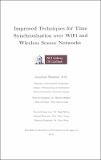| dc.description.abstract | Time synchronisation plays a key and ever increasing role in this progressively
networked world. Whilst time synchronisation has always
been important in industrial and telecommunication systems, its importance
has now extended to more diverse applications such as consumer
multimedia, medical informatics, SmartGrid, and environmental
monitoring. As the need for time synchronisation has grown, so
too has the need for such time-sensitive applications to be deployed
over wireless networks. It is estimated that there are more than twelve
and a half billion Internet-enabled devices connected at the moment -
this is expected to reach somewhere between twenty and fifty billion
by 2020, as the so-called `Internet-of-things' evolves. Much of this
connectivity will be via wireless.
The rapid expansion of wireless networks in the last two decades has
drastically transformed the architecture of many traditional packet-switched
networks. This is particularly the case with TCP/IP based
Local Area Networks (LANs) which form a significant building block
of the internet. Wireless networks have become ubiquitous within the
internet, key amongst them being 802.11 based technologies that now
commonly represent the last hop. Whilst hugely convenient, such networks
present many new challenges in terms of time synchronisation.
In particular, 802.11 or WiFi marks a return to contention based access
which can lead to significant delays that are often asymmetric.
This greatly degrades the performance of common synchronisation
protocols that are designed for largely symmetric wired networks.
Another wireless based network has experienced significant, albeit less
spectacular growth in the last decade, namely, Wireless Sensor Net-
works (WSNs). They provide a means to gather physical data via
a wireless network of low-powered, inexpensive computing devices.
These miniature devices, although limited in terms of power and computing
resources, have huge potential when used in a distributed fashion.
They can be used to collect sensory data from large geographical
areas which, when collated, can provide invaluable insight into a phenomenon
under observation. Data collected via WSNs often requires
precise time stamping, and thus, in such cases, WSNs require time
synchronisation protocols in order to operate effectively. Since the
computing devices that compose a WSN are typically power-limited,
the overhead of a time synchronisation protocol can use up valuable
energy, thus, limiting node life.
The research contributions in this thesis address key synchronisation
problems within both 802.11 and WSN domains. The significant problem concerning the degradation of time protocols operating
over 802.11 networks is remedied via a novel mechanism that exploits
the standard operation of 802.11 networks in order to reduce the error
in datasets employed by such protocols. Validation experiments
performed confirm that the mechanism can deliver synchronisation
accuracies akin to those achievable over wired networks.
In relation to WSNs, the research contribution addresses the key problem
of communication (and thus energy) overhead for synchronisation
protocols. This contribution is presented by means of a new protocol,
termed the Dynamic Flooding Time Synchronisation Protocol (D-
FTSP) which offers an energy efficient means of synchronising WSNs
deployed in dynamic environments. Experiments reveal that D-FTSP,
in particular scenarios, can result in significant energy savings with
respect to alternative time protocols, thus, greatly extending the life
of a WSN. | en_US |


